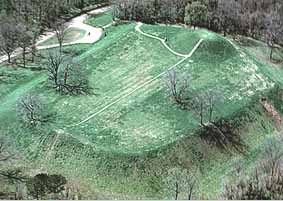|
Glass Site
The Glass site (Smithsonian trinomial, 22 WR 502) is a Plaquemine culture archaeological site located approximately south of Vicksburg, Mississippi, Vicksburg in Warren County, Mississippi. Originally the site had four platform mounds surrounding a large open plaza, but land leveling for modern farming techniques and looting by pothunters mean only portions of three have survived into the 21st century. It was a major ceremonial center that was contemporaneous with other large Plaquemine sites including Emerald Mound Site, Emerald, Holly Bluff site, Holly Bluff, and Winterville site, Winterville and whose main occupation period occurred during the protohistoric period from 1500 to 1650 CE. Parts of the site were excavated by Clarence Bloomfield Moore in 1910 and 1911, and by Lauren Elizabeth Downs in 2007-2009. The mounds are listed on the Mississippi Mound Trail. Site chronology The Glass site sits on the northern edge of the area covered by the Natchez Bluff phase, immediately so ... [...More Info...] [...Related Items...] OR: [Wikipedia] [Google] [Baidu] |
Vicksburg, Mississippi
Vicksburg is a historic city in Warren County, Mississippi, United States. It is the county seat, and the population at the 2010 census was 23,856. Located on a high bluff on the east bank of the Mississippi River across from Louisiana, Vicksburg was built by French colonists in 1719, and the outpost withstood an attack from the native Natchez people. It was incorporated as Vicksburg in 1825 after Methodist missionary Newitt Vick. During the American Civil War, it was a key Confederate river-port, and its July 1863 surrender to Ulysses S. Grant, along with the concurrent Battle of Gettysburg, marked the turning-point of the war. The city is home to three large installations of the United States Army Corps of Engineers, which has often been involved in local flood control. Status Vicksburg is the only city in, and the county seat of, Warren County, Mississippi, United States. It is located northwest of New Orleans at the confluence of the Mississippi and Yazoo rivers, and ... [...More Info...] [...Related Items...] OR: [Wikipedia] [Google] [Baidu] |
Natchez People
The Natchez (; Natchez pronunciation ) are a Native American people who originally lived in the Natchez Bluffs area in the Lower Mississippi Valley, near the present-day city of Natchez, Mississippi in the United States. They spoke a language with no known close relatives, although it may be very distantly related to the Muskogean languages of the Creek Confederacy.Geoffrey Kimball, "Natchez" in ''Native Languages of the Southeastern United States'', ed. Janine Scancarelli and Heath ... [...More Info...] [...Related Items...] OR: [Wikipedia] [Google] [Baidu] |
Routh Phase
Routh Mounds is a Plaquemine culture archaeological site in Tensas Parish, Louisiana. It is the type site for the ''Routh Phase(1200 to 1350 CE)'' of the Tensas Basin Plaquemine Mississippian chronology. It is located approximately northwest of the Winter Quarters State Historic Site Winter Quarters in Tensas Parish, Louisiana, United States, is a surviving example of an antebellum cotton plantation. It is located south of Newellton on Lake St. Joseph, an ox-bow lake, or former bend in the Mississippi River. History The mai .... See also * Culture, phase, and chronological table for the Mississippi Valley * Balmoral Mounds * Flowery Mound * Ghost Site Mounds * Sundown Mounds References External links * {{Pre-Columbian North America Plaquemine Mississippian culture Mounds in Louisiana Geography of Tensas Parish, Louisiana ... [...More Info...] [...Related Items...] OR: [Wikipedia] [Google] [Baidu] |
Winterville Phase
The Winterville site ( 22 WS 500) is a major archaeological site in unincorporated Washington County, Mississippi, north of Greenville and along the river. It consists of major earthwork monuments, including more than twelve large platform mounds and cleared and filled plazas. It is the type site for the ''Winterville Phase (1200 to 1400)'' of the Lower Yazoo Basin region of the Plaquemine Mississippian culture. Protected as a state park, it has been designated as a National Historic Landmark. In June 2015 the state authorized $300,000 to restore the mounds to their pre-Columbian condition and add walking trails to the park. Mound Site Restoration Project Funded" Mississippi Dept. of Archives and History, 5 June 2015 The site also includes a museum. Winterville Mounds Winterville Mounds, named for the nearby town of Winterville, Mississippi, is the site of a prehistoric ceremonial center built by Native Americans of the Plaquemine culture, the regional variation of ... [...More Info...] [...Related Items...] OR: [Wikipedia] [Google] [Baidu] |
Fitzhugh Phase
Fitzhugh Mounds is an archaeological site in Madison Parish, Louisiana from the Plaquemine\Mississippian period dating to approximately 1200–1541 CE. It is the type site for the ''Fitzhugh Phase(1350–1500)'' of the Tensas Basin Plaquemine Mississippian chronology. Description The site was once an impressive seven-mound complex, with four of the platform mounds surrounding a central plaza. The site is first mentioned in E. G. Squier and E. H. Davis' '' Ancient Monuments of the Mississippi Valley'' in 1848. The largest mound at the site, at in height, was bulldozed and carted away to use as fill during the construction of Interstate 20. Other of the mounds have been extensively plowed by local farmers and only two of the original seven mounds remain. Mound B is in height. Mound D serves as an active historic cemetery and is approximately in height. Location The site is located on La 602 south-southwest of its junction with I-20 Interstate 20 (I‑20) is a major e ... [...More Info...] [...Related Items...] OR: [Wikipedia] [Google] [Baidu] |
Lake George Phase
The Holly Bluff site ( 22 YZ 557), sometimes known as the Lake George Site, and locally as "The Mound Place," is an archaeological site that is a type site for the Lake George phase of the prehistoric Plaquemine culture period of the area. The site is on the southern margin of the Mississippian cultural advance down the Mississippi River and on the northern edge of that of the Cole's Creek and Plaquemine cultures of the South." The site was first excavated by Clarence Bloomfield Moore in 1908 and tested by Philip Phillips, Paul Gebhard and Nick Zeigler in 1949. It was declared a National Historic Landmark in 1964. The mounds are listed on the Mississippi Mound Trail. Location One of the half dozen really big sites in the State of Mississippi, the Holly Bluff site is located on the south bank of George Lake, or Lake George as it is sometimes known, a half mile east of its confluence with the Sunflower River and a mile and a half southeast of the village of Holly Bluff, Yazo ... [...More Info...] [...Related Items...] OR: [Wikipedia] [Google] [Baidu] |
Foster Phase
Foster's Mound ( 22 AD 503) is a Plaquemine culture archaeological site located in Adams County, Mississippi northeast of Natchez off US 61. It is the type site for the ''Foster Phase (1350-1500 CE)'' of the Natchez Bluffs Plaquemine culture chronology. It was added to the NRHP on September 2, 1982 as NRIS number 82003091. The mounds are listed on the Mississippi Mound Trail. Description The Foster's site has two platform mounds and is located on the northern bank of St. Catherine Creek near its confluence with the Mississippi River. The largest mound, Mound A, is in height and by at its base and has had a plantation house on its summit since the 1790s. Its dimensions were originally smaller but it was enlarged to accommodate the veranda of the plantation house. Mound B is to the south across a large plaza area. It is an amorphous blob about at its highest point. It has been seriously eroded by the creek and is barely recognizable as a rectangular platform mound. The ... [...More Info...] [...Related Items...] OR: [Wikipedia] [Google] [Baidu] |
Transylvania Phase
Transylvania Mounds is an archaeological site in East Carroll Parish, Louisiana with components from the Coles Creek (700–1200)CE and Plaquemine/ Mississippi periods (1200–1541). It is the type site for the ''Transylvania Phase (1500-1680 CE)'' of the Tensas Basin Plaquemine Mississippian chronology. Description A large multimound site with two plazas and possibly as many as twelve mounds. The largest mound at the site was in height and was flanked on two sides by the plazas. Several of the mounds are no longer visible because intensive European farming methods have leveled them. The ones that do remain are , , , , and in height. The site underwent limited archaeological testing in the 1960s. These tests dated occupation of the site about 700–1200 CE during the Coles Creek period. Other ceramics discovered at the site were dated to 1200–1541 during the Plaquemine Mississippian The Plaquemine culture was an archaeological culture (circa 1200 to 1700 CE) centered o ... [...More Info...] [...Related Items...] OR: [Wikipedia] [Google] [Baidu] |
Wasp Lake
A wasp is any insect of the narrow-waisted suborder Apocrita of the order Hymenoptera which is neither a bee nor an ant; this excludes the broad-waisted sawflies (Symphyta), which look somewhat like wasps, but are in a separate suborder. The wasps do not constitute a clade, a complete natural group with a single ancestor, as bees and ants are deeply nested within the wasps, having evolved from wasp ancestors. Wasps that are members of the clade Aculeata can sting their prey. The most commonly known wasps, such as yellowjackets and hornets, are in the family Vespidae and are eusocial, living together in a nest with an egg-laying queen and non-reproducing workers. Eusociality is favoured by the unusual haplodiploid system of sex determination in Hymenoptera, as it makes sisters exceptionally closely related to each other. However, the majority of wasp species are solitary, with each adult female living and breeding independently. Females typically have an ovipositor f ... [...More Info...] [...Related Items...] OR: [Wikipedia] [Google] [Baidu] |
Emerald Phase
The Emerald Mound site ( 22 AD 504), also known as the '' Selsertown site'', is a Plaquemine culture Mississippian period archaeological site located on the Natchez Trace Parkway near Stanton, Mississippi, United States. The site dates from the period between 1200 and 1730 CE. It is the type site for the ''Emerald Phase (1500 to 1680 CE)'' of the Natchez Bluffs Plaquemine culture chronology and was still in use by the later historic Natchez people for their main ceremonial center. The platform mound is the second-largest Mississippian period earthwork in the country, after Monk's Mound at Cahokia, Illinois. The mound covers eight acres, measuring by at the base and is in height. Emerald Mound has a flat top with two smaller secondary mounds at each end. It was constructed around a natural hill. Travelers in the early 19th century noted a number of adjoining mounds and an encircling ditch that are no longer present. This site once had six other secondary mounds which were lost ... [...More Info...] [...Related Items...] OR: [Wikipedia] [Google] [Baidu] |
Mississippian Culture
The Mississippian culture was a Native Americans in the United States, Native American civilization that flourished in what is now the Midwestern United States, Midwestern, Eastern United States, Eastern, and Southeastern United States from approximately 800 CE to 1600 CE, varying regionally. It was known for building large, earthen platform mounds, and often other shaped mounds as well. It was composed of a series of urban settlements and satellite villages linked together by loose trading networks. The largest city was Cahokia, believed to be a major religious center located in what is present-day southern Illinois. The Mississippian way of life began to develop in the Mississippi River Valley (for which it is named). Cultures in the tributary Tennessee River Valley may have also begun to develop Mississippian characteristics at this point. Almost all dated Mississippian sites predate 1539–1540 (when Hernando de Soto explored the area), with notable exceptions being Natchez p ... [...More Info...] [...Related Items...] OR: [Wikipedia] [Google] [Baidu] |




